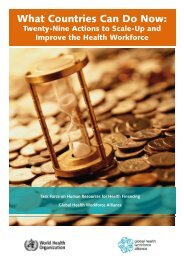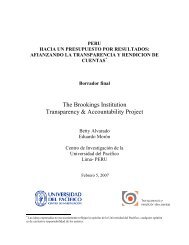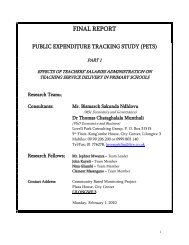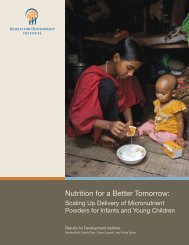Provider Purchasing and Contracting for Health Services_The Case
Provider Purchasing and Contracting for Health Services_The Case
Provider Purchasing and Contracting for Health Services_The Case
You also want an ePaper? Increase the reach of your titles
YUMPU automatically turns print PDFs into web optimized ePapers that Google loves.
use <strong>and</strong> patient in<strong>for</strong>mation <strong>for</strong> MoH regarding the partnerships whenever we exhaust the<br />
supplies they give us. To my disappointment, government never collects the in<strong>for</strong>mation <strong>and</strong><br />
when given to them, they do not take it on board <strong>and</strong> keep complaining that the private sector<br />
is not cooperating.”<br />
In his view, less government interference <strong>and</strong> concern about the private sector has facilitated<br />
the sector’s growth. Given this background, managers of private <strong>for</strong>-profits observed that a<br />
voucher system allowing private practitioners to claim fees (incurred by patients who cannot<br />
af<strong>for</strong>d full payments) could be developed <strong>and</strong> managed by an independent body.<br />
Partnerships in public health programs with companies<br />
<strong>The</strong> government <strong>and</strong> the private sector, especially in the Copperbelt Province of Zambia,<br />
have a long history of partnerships in public health programs. <strong>The</strong> partnerships are mainly in<br />
prevention programs. <strong>The</strong>se are discussed below.<br />
Malaria <strong>and</strong> rabies prevention programs: Private mines provide technical <strong>and</strong> material<br />
support to the District <strong>Health</strong> Management Teams in the malaria control program. <strong>The</strong><br />
Copperbelt Province has a long history of malaria control, practices since the early 1940s by<br />
the predecessor mining firms as essentially an economic <strong>and</strong> productivity enhancement<br />
measure to curb malaria-related morbidity, which had direct economic/financial <strong>and</strong><br />
productivity-related effects. This led to private-public partnerships in public health control.<br />
This collaboration, although systematically <strong>and</strong> continuously undertaken, has not been<br />
<strong>for</strong>malized through any arrangement equivalent to an agreement or contract; rather, through<br />
the establishment of the District <strong>Health</strong> Boards, the contribution of the mining firms <strong>and</strong><br />
health services were captured as partnership programs in work plans <strong>and</strong> budgets. Partners<br />
agree to meet some aspects of the prevention programs. For instance, indoor residual<br />
spraying, a malaria prevention program, is the biggest partnership. Under this partnership<br />
program, mines <strong>and</strong> District <strong>Health</strong> Management Teams unequally share residential areas or<br />
housing units that each party has to cover. 9 Based on past experiences, each party contributes<br />
funds to jointly procure chemicals sufficient to cover the housing units in the shared areas. In<br />
addition, both parties are involved in community education <strong>and</strong> sensitization about specific<br />
programs<br />
Under these partnerships, mines are expected to train <strong>and</strong> provide protective clothing to the<br />
staff involved in the spraying. Mines also provide storage facilities <strong>for</strong> the equipment <strong>and</strong><br />
chemicals that are used during the anti-malaria campaigns.<br />
Promotion of partnerships with the private sector<br />
<strong>The</strong> Ministry of <strong>Health</strong> has started to strengthen its relations with the private commercial<br />
sector as part of the overall investment strategy from the Cabinet Office. <strong>The</strong> initiative<br />
“Triangle of Hope” aims at increased investments in the health sector. Priority areas are hightech<br />
medical services, manufacturing of pharmaceutical products, medical laboratory<br />
services, diagnostic services, repair <strong>and</strong> maintenance of medical equipment, laundry services<br />
to medical institutions, ambulance services, <strong>and</strong> human resources <strong>for</strong> health development.<br />
9 Based on the interviews, mines often cover a relatively larger number of housing units than the Ministry of<br />
<strong>Health</strong> covers.<br />
56
















